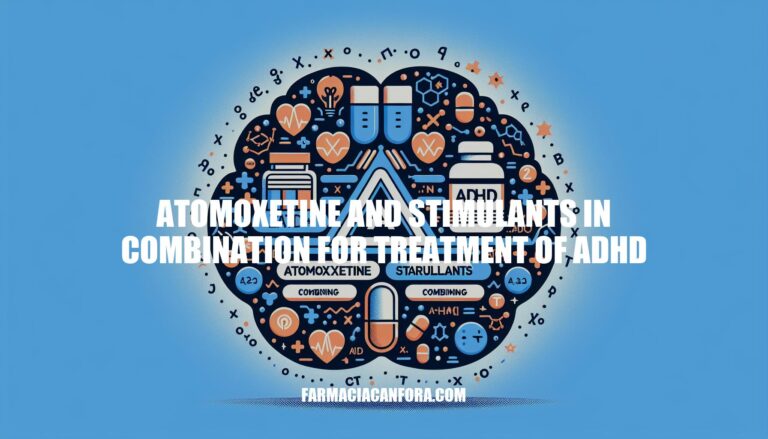Combining atomoxetine, a non-stimulant, with stimulant medications for ADHD treatment aims to optimize symptom management. This approach can be particularly beneficial for individuals who do not respond adequately to single-medication therapy. By leveraging the distinct mechanisms of both drug types, this combination can enhance overall effectiveness and improve patient outcomes.
Mechanism of Action
Here’s a concise explanation:
Atomoxetine
- Mechanism: Atomoxetine is a selective norepinephrine reuptake inhibitor (NRI). It increases norepinephrine levels by inhibiting its reuptake in the brain, particularly in the prefrontal cortex, which is crucial for attention and impulse control.
- Effects: It helps improve attention and reduce impulsivity and hyperactivity in individuals with ADHD. Atomoxetine is non-stimulant and has a lower risk of abuse compared to stimulants.
Stimulants
- Mechanism: Stimulants like methylphenidate and amphetamines increase the levels of dopamine and norepinephrine in the brain by blocking their reuptake and promoting their release.
- Effects: They enhance focus, attention, and control over impulses. Stimulants are fast-acting and are often the first-line treatment for ADHD.
Combination Therapy
- Mechanism: Combining atomoxetine with stimulants can provide a synergistic effect. Atomoxetine’s steady increase in norepinephrine complements the rapid action of stimulants on dopamine and norepinephrine.
- Effects: This combination can be beneficial for patients who do not respond adequately to either medication alone, offering improved symptom control and potentially reducing side effects by allowing lower doses of each medication.
Clinical Evidence
Clinical studies have explored the combination of atomoxetine and stimulants for ADHD treatment, focusing on efficacy, safety, and outcomes.
-
Efficacy: Studies indicate that combining atomoxetine, a selective norepinephrine reuptake inhibitor, with stimulants like methylphenidate can improve ADHD symptom control in some patients. This combination is often used when monotherapy is insufficient.
-
Safety: The combination therapy is generally well-tolerated, though it may increase the risk of adverse effects compared to monotherapy. Common side effects include insomnia, decreased appetite, and gastrointestinal issues.
-
Key Findings:
- Improved Symptom Control: Some patients show significant improvement in attention and hyperactivity/impulsivity symptoms.
- Adverse Events: No serious adverse events were reported in most studies, but monitoring is recommended.
-
Outcomes: The combination therapy can be particularly beneficial for patients with comorbid conditions or those who do not respond adequately to single-drug treatment.
Benefits of Combination Therapy
Combining atomoxetine with stimulants for ADHD treatment offers several benefits:
- Improved Symptom Control: The combination can significantly reduce ADHD symptoms, including inattention, hyperactivity, and impulsivity, more effectively than either medication alone.
- Extended Duration of Relief: This approach can extend the duration of symptom relief throughout the day.
- Reduced Side Effects: Using both medications can help mitigate side effects associated with higher doses of a single medication, such as mood swings, irritability, and sleep disturbances.
- Enhanced Functional Outcomes: Patients often experience better overall functioning, including improved academic and social performance.
Safety and Tolerability
Combining atomoxetine and stimulants for ADHD treatment can be effective but requires careful management. Here are the key points:
Safety and Tolerability
- General Tolerability: Combination therapy is generally well-tolerated.
- Common Side Effects: Potential side effects include insomnia, decreased appetite, and gastrointestinal issues.
- Serious Adverse Events: No serious adverse events have been consistently reported.
Management Strategies
- Monitoring: Regular monitoring of heart rate, blood pressure, and mental health is crucial.
- Dosage Adjustments: Adjusting dosages based on individual response and side effects can help optimize treatment.
- Gradual Introduction: Introducing one medication at a time and gradually increasing the dose can minimize side effects.
Patient Selection
Patients who may benefit from combination therapy with atomoxetine and stimulants for ADHD treatment typically meet the following criteria:
- Partial Response to Monotherapy: Patients who do not achieve sufficient symptom control with either a stimulant or atomoxetine alone.
- Side Effects: Those experiencing significant side effects from higher doses of a single medication, making it necessary to lower the dose and add another medication.
- Comorbid Conditions: Patients with additional conditions that complicate treatment, such as anxiety or mood disorders.
- Misuse Concerns: Individuals at risk of misusing stimulants may benefit from the addition of a non-stimulant like atomoxetine.
These criteria help optimize ADHD symptom management while minimizing side effects and addressing individual patient needs.
Combining Atomoxetine with Stimulants: A Beneficial Approach for ADHD Treatment
Combining atomoxetine with stimulants can be beneficial for individuals who do not respond adequately to single-medication therapy. This approach leverages the distinct mechanisms of both drug types, enhancing overall effectiveness and improving patient outcomes.
Atomoxetine is a selective norepinephrine reuptake inhibitor that increases norepinephrine levels in the brain, while stimulants like methylphenidate and amphetamines increase dopamine and norepinephrine levels by blocking their reuptake and promoting their release. The combination can provide a synergistic effect, improving symptom control and potentially reducing side effects.
Key Findings from Clinical Studies
Clinical studies have explored this combination for ADHD treatment, focusing on efficacy, safety, and outcomes. Key findings include:
- Improved symptom control
- Reduced adverse events
- Enhanced functional outcomes
However, careful management is required due to potential side effects and the need for regular monitoring of heart rate, blood pressure, and mental health.
Who May Benefit from Combination Therapy?
Patients who may benefit from combination therapy typically meet specific criteria, including:
- Partial response to monotherapy
- Significant side effects
- Comorbid conditions
- Misuse concerns


